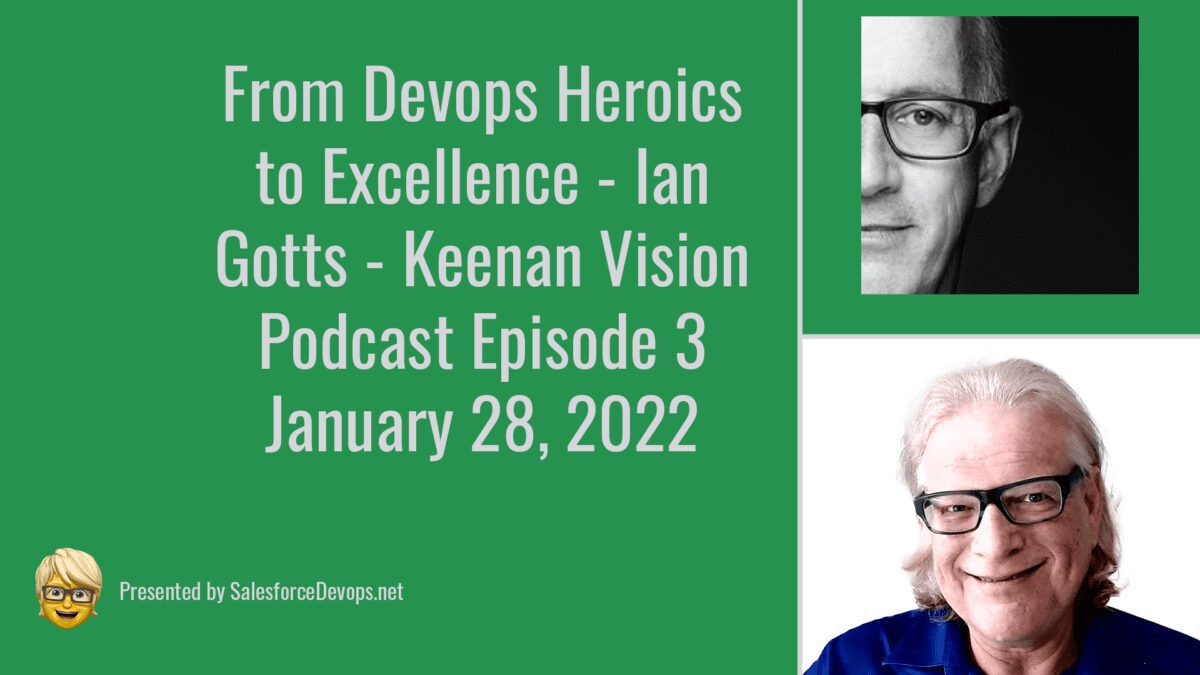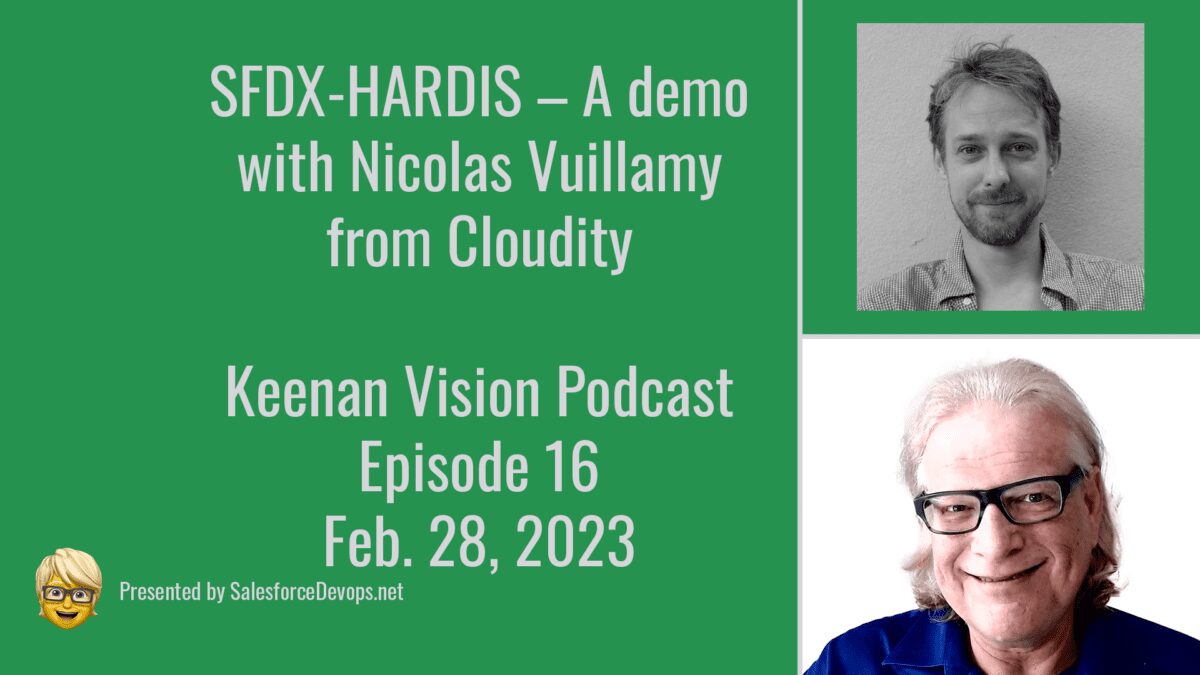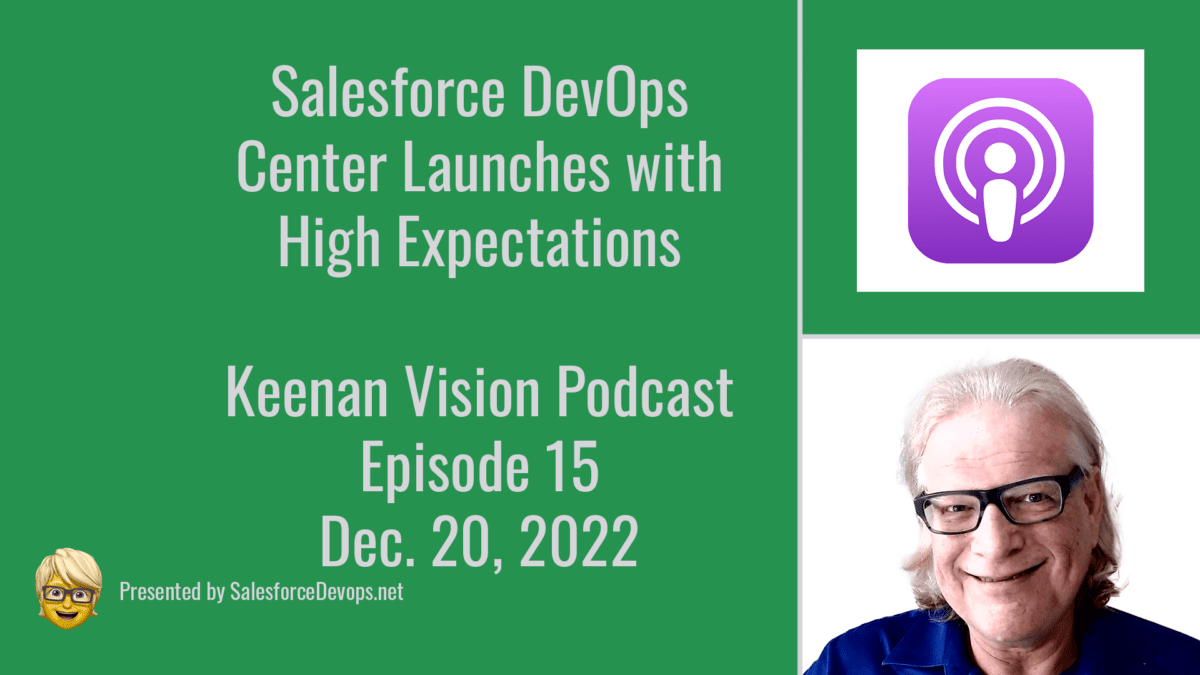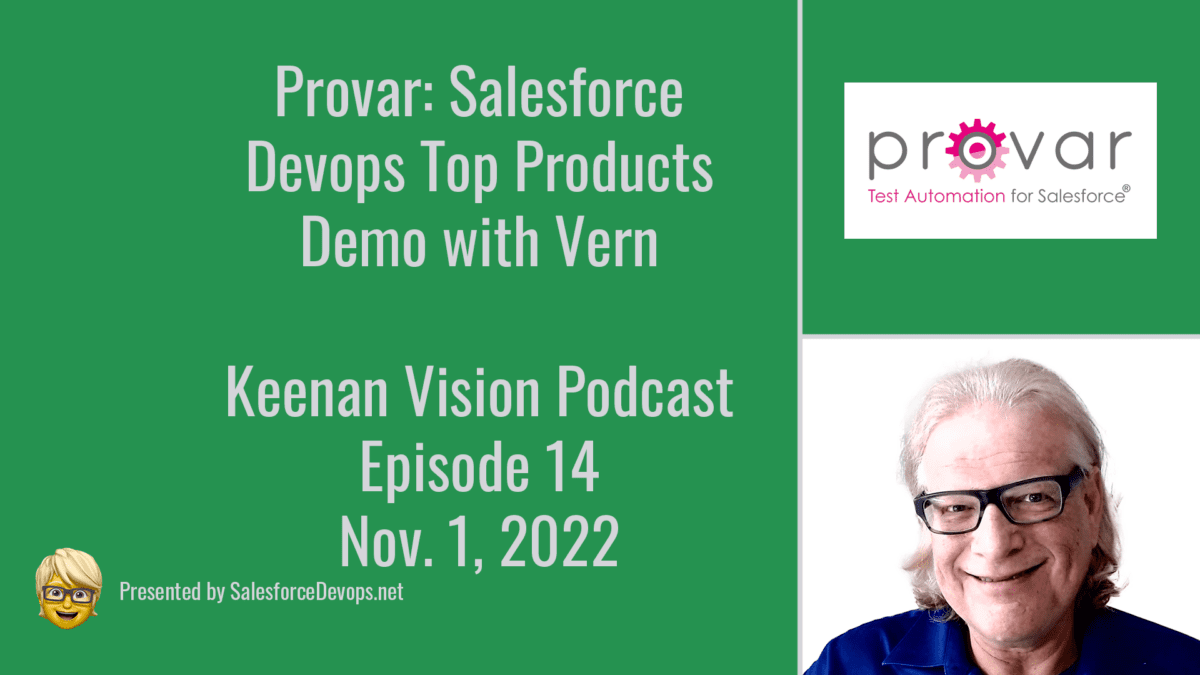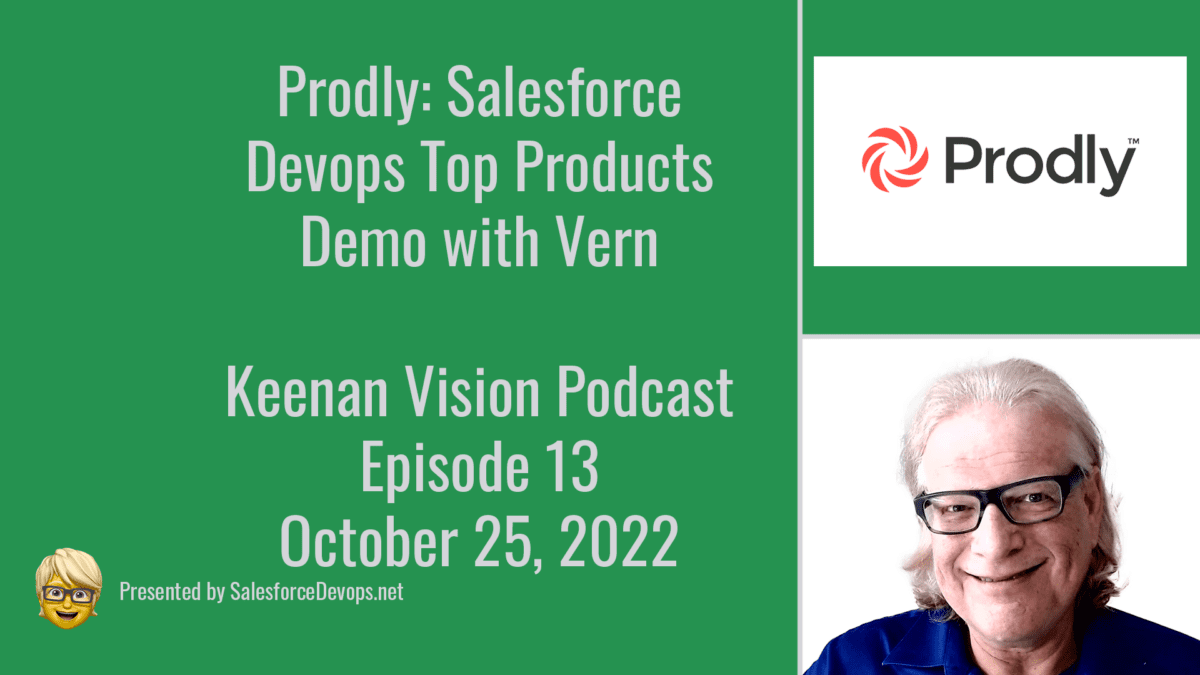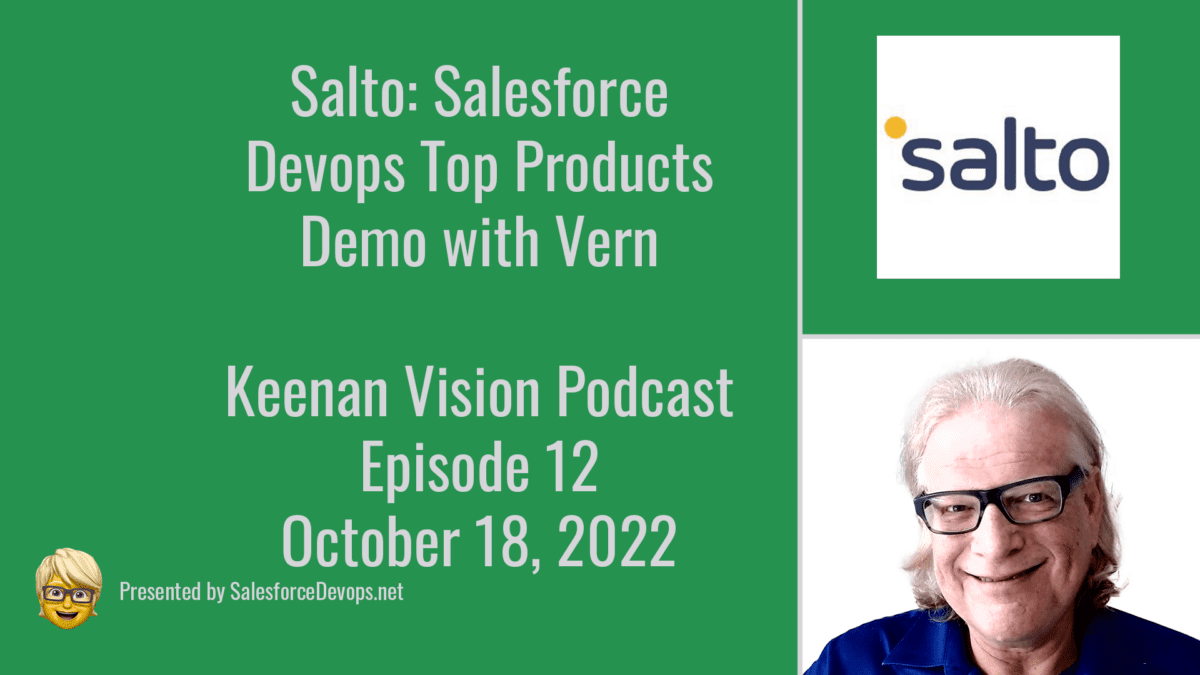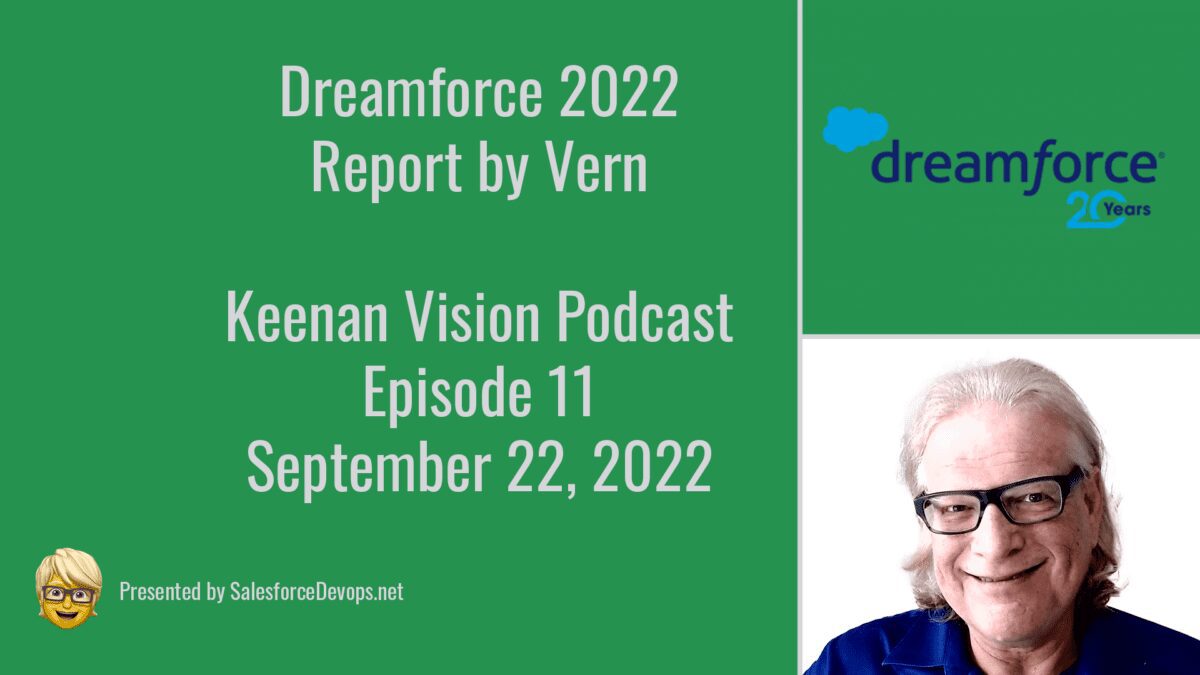From Devops Heroics to Excellence – Ian Gotts – Keenan Vision Podcast Episode 3 January 28, 2022
Description
Join the Keenan Vision Podcast for a fascinating and important interview of Ian Gotts, CEO of Elements.Cloud, by Vernon Keenan. We get to hear Ian’s insights into the Center of Excellence, devops, business analysis, and going from heroics to excellence!
Listen On Anchor
Watch on YouTube
Subscribe With Your Favorite App
Be sure to subscribe to get all the upcoming episodes downloaded automatically to your podcasting app.
Overview
Here are some of the key points covered:
- How did Ian get so smart about application delivery and devops?
- What is Elements.Cloud as a product?
- Who is the Elements.Cloud customer?
- Ian describes how he has focused on the Salesforce Center of Excellence and how that has benefited users and platform owners
- Ian touches several times how devops has to move from “heroics to excellence”
- We give lots of love to people who want to enter the ecosystem and take advantage of trends with some career advice
Show Notes/Transcript
Vernon Keenan:
Welcome, everybody, to the Keenan Vision podcast interview series. This week we’re talking to Ian Gotts, CEO and founder of Elements Cloud here in Northern California. And Ian, tell us a little bit about Elements Cloud.
Ian Gotts:
Well, I guess it started 20 years ago because we were customers then of Salesforce when it’s just two people in the office in London. And we saw Salesforce grow from being what was an SFA Salesforce automation platform to what it is now, a real enterprise platform. And as it’s grown, it needs enterprise tooling. And we’re seeing that in the DevOps space.
We’re seeing a number of players there. And we recognize there’s an opportunity in the business analysis space, all the things that happened before DevOps, that we needed enterprise scale tooling there to really help customers accelerate their understanding about what’s in your build better applications and most importantly, accelerate their time to value for Salesforce.
Vernon Keenan:
Now, I think one thing that we have to concede about DevOps and the kind of enterprise application, the delivery stuff that we talk about a lot is it’s pretty complex, really. It covers a lot of topics. So why don’t you tell us a little bit about maybe how you got up to this perch of being able to understand some of how to make these flows work?
Ian Gotts:
Yeah. I think part of it, though, is that being old, I’ve been around a long time and you can remember when we were building systems on mainframes. The basic principles behind what it takes to build an application is you need to understand requirements. You need to make sure that you bunch up the technology stack. You then go and build it. You do use acceptance testing and you deliver it. Now that’s become a lot easier with low current applications. But the same basic principles need to be there.
And as you said, Salesforce is getting a lot more complex. Not just the platform is more complex, but there are a lot more moving parts. There are integrations to Slack, integrations to third party applications, integrations to other platforms that Salesforce has required. We need to make sure those stay in step.
And therefore DevOps can’t just be I hit a button and it’s now in production. There are more implications. And I think that’s where if you just think about what it takes to what release means, release is not just a line of code. It could be links to other applications, training material. There’s a whole series of things we now need to release. And I think if you think about that broader picture about release, you understand why DevOps is no longer a small bit of software. Actually, it’s a discipline. It’s an approach.
And I think Salesforce customers, some of them are still at the heroics level of DevOps. They’re doing the best they can, maybe with chain sets, and they need to get to DevOps excellence. And I know you and I got a session coming up, a panel session coming up in a week or two where we’re talking about DevOps excellence with some experts who really have reached that pinnacle. And I think our job for all of us is to help people go through the journey to get to DevOps.
Vernon Keenan:
So there you’re talking about, I think, another way to classify what you’re talking about. There is high performing teams that use DevOps as kind of an enablement or like a way for them to build up their practices. Is that where we’re going? There are DevOps principles?
Ian Gotts:
Absolutely. And there’s some DevOps processes, but then you need to underpin that with automation, as with everything. So you need the DevOps platforms that enable you to do that at scale, accurately, quickly.
Vernon Keenan:
And isn’t there kind of like a collision between what we say is DevOps, which a lot of people think of as process and tooling and things like that, and agile management, where you want to think about how to manage a project with a scrum team or with work items and things of that nature?
Ian Gotts:
Oh, I think we’re the same thing. I think the agile team have gone: don’t worry, we can do things really quickly because we can miss stuff out. We don’t need to do documentation. We don’t need to do testing. Agile is about, let’s make the work items smaller so we can deliver them more quickly so we’re more in step with the business. In fact, agile requires great DevOps because actually, if you want to do things quickly and accurately, you need a platform behind you which supports you. Agile done manually is really hard. Agile done with great tooling. Actually, you genuinely can fulfill the promise of agile rather than the view of agile, which is we got it going quickly because we missed stuff out, and then that will then catch up with us later.
Vernon Keenan:
So, Ian, I think a lot of people know you from the Salesforce community. You’ve been around a little bit. Something I’d like to know is when you were very young, how did you first get enchanted with technology?
Ian Gotts:
That’s interesting. I’ve always been really from the business in the house as well. I think in my first job at Accenture, I was involved in implementing systems. But from a business perspective. So we’re looking at an ERP system. But it was pretty clear then that everything runs on technology. I mean, I couldn’t have predicted where we are now. Maybe if I had, I would have bought Apple shares or sales force or whatever.
But the point is, even then, back in 1986, it was clear the only way you were going to build an aircraft was by having an ERP system which had accurate bills of material and accurate data that was the back office system. At that point, Salesforce was really in its infancy. We were using apps and spreadsheets to manage customer data. Siebel was this big monster that it was too expensive to maintain, too expensive to implement.
Salesforce came in and really they said, let’s make it as easy as buying a book on Amazon. Let’s make building a CRM system as easy as that. And at that point, you suddenly went, Hang on, I’m no good at coding when I can actually deliver stuff. And I think that if we just roll over for 20, 30, 40 years, you think what people are now doing the code, people with relatively technical skills can now build fairly sophisticated systems. That’s the problem with technology.
Vernon Keenan:
Now, your company got an investment late last year, and I presume you’ve been growing quite a bit. I think we need to kind of confirm some obvious things that we notice around us. Salesforce Sales have been skyrocketing. So I presume you’ve been seeing a lot of interest from bigger companies and other folks trying to do digital transformations and big projects with Salesforce.
Ian Gotts:
Yeah. Okay. So in the last two years, we’ve been stuck at home. Covid has accelerated digital transformation for pretty much every company. Everyone was scrabbling to go, okay, we need an online presence. Salesforce was the obvious candidate there to say, well, to do that properly, you need all your customization in one place. And I think that’s a real driver for why customers have been adopting Salesforce. That’s the first thing. And the second thing is Salesforce has so much power now, the ability to connect to third party systems.
It’s suddenly safe. It’s suddenly the enterprise application.
When Salesforce first launched back in 2000, Gartner’s prediction was, it won’t work, it will get killed. Look where we are now. It’s now a credible platform, absolutely incredible platform that every brand name you can think of relies on. So absolutely, we’re now at a point where big customers are relying on Salesforce, which is back to the conversation we started with, which is now they require enterprise scale tooling for everything around lifecycle, business analysis, understanding your work development, test, training, and then back up and then round that slide.
Vernon Keenan:
So why don’t you give us just kind of like a little elevator pitch on Elements cloud?
Ian Gotts:
Okay, that’s pretty easy. It’s very difficult to manage a Salesforce.org if you don’t understand it. So at the heart of Elements is the ability to very quickly pull all the metadata out and then build a map of the dependencies, the impact. So very quickly you understand the.org once you’ve got that in place, you can then start moving from heroics to excellence.
So it’s about managing your better, doing better business analysis, making sure the user storage you passed DevOps are complete thought through. We have an impact assessment. We can do some view of assessing how much effort it takes, and then when it comes to delivery. We’ve got the training content there.
So we’re really trying to support that whole lifecycle. But it starts with all discovery, whether you’re a new admin, a platform owner who’s trying to work out what’s been implemented, or you’re a consultant going into a new client.
We’ve got a huge number of consultants now buying a consulting license to go, and this is plug it in two minutes, an hour or two later, I X ray vision about what I walked into in terms of the client’s implementation.
Vernon Keenan:
I think that’s so powerful because there’s no such thing in Salesforce. To be able to get like a snapshot of the source code of the thing so that you could examine it. You really need these discovery tools and what I call metadata intelligence and change management tools. Change intelligence, which is Elements has been doing some leadership in that in terms of providing those tools to developers and to consultants. So I think that’s great.
What kind of customer is like a big customer that comes in? Tell us a little bit about kind of why they hired you and what the onboarding and engagement process would be like.
Ian Gotts:
Okay, so I think our sweet spot is a customer who’s got the Salesforce last at least three years. But we’ve had customers who’ve had Salesforce for 17 years. So you think how much development, how many different SIs have had to go at it, how much growth has happened there and how little understanding about what’s been changed.
So onboarding is it could be a proof of concept to start with. That proof of concept. Let’s connect Elements to your walk. Maybe it’s a full sandbox, maybe it’s production, and that takes a couple of minutes. Let’s pull out all the metadata, and then our engine go away and build the metadata dictionary, build the impact analysis, build all the dependency trees. So at least you’ve got a starting point.
And then you’ve got a snapshot of view about what the audience looks like. And sometimes it’s the first time they’ve ever seen it. It’s almost like the first person who’s ever been into an X ray scanner and gone, wow, there’s a small beat. There’s a human inside of it. No, that’s your skeleton. Oh, is it? Right.
So sometimes it’s the first time they’ve ever seen they look at it and go, Why have we got 255 record types on account? I’ve no idea. Right. Okay. But how many of those are used? That’s the important question. Oh, right. Most of them aren’t used to. So it’s maybe not that big an issue. So a lot of this is actually really understanding how it’s been configured, where the errors of technical debt are, where the errors of risk are. I mean, everyone says technical debt is bad. It isn’t. Technical debt is inevitable. Technical debt in an area which should never be changed.
Technical debt in an area we’re trying to change all the time. Is an issue because it’s a cost. And if you can’t tell the difference between those different areas, you start work and it blows up in your face or you overrun because you didn’t realize how complex it was. So I think indexing the order. Then our dependency tree where you can click on go, okay, that now is touched by those things. Wow. That’s touched by right now we’ve got a better handle on the implications of changing and that field or that flow.
So if you think about Salesforce has got a big push at the moment to migrate, everyone from process builder, workflows and workflow rules across the flow. Right.
The first question is which ones are even being used? The second question is for those I’ve got to migrate, how long it’s going to take, how complex are they? We can tell you that. So you can decide which ones are heavily used, which ones you want to migrate most quickly. So again, it’s just helping you navigate your way around the org prioritize work, and understand the risks.
Vernon Keenan:
So that sounds like you’re using your metadata database to kind of help find anomalies and errors and then to help prioritize the work in terms of what needs to be cleaned up in order to implement a new feature or maybe just to manage technical debt a little better or something like that.
Ian Gotts:
Yeah, absolutely. And quite often a customer has a specific. They want to implement CPQ, they want to implement a new cloud, they want to migrate, they want to merge towards people, don’t come to us and go, wow, that’s interesting. I wonder what I could do with it. They want to do something and we’re actually the tourist. Exposes it to make it easier, reduces the risk, makes it quicker.
Vernon Keenan:
Well, that is another question that I had. Which is why do they need you per se? Is it this cleanup aspect? Are they trying to do a brand new project or do they face regulatory concerns? They’re just trying to do it right from the beginning.
Ian Gotts:
I think it varies by customer. I mean, every customer is there (unintel.). Salesforce has always got projects want they to create. It’s a new cloud. It’s migrating to merging towards. It is migrating from workflow to flow. There is a project there. No matter what that project is, they need better visibility of the implications of making those changes. Better that you find it in the analysis phase than you find it in development or in production.
I mean, everyone’s heard of shift left. Let’s find the problems early. So if we can expose an issue rather than finding in production many times cheaper
Vernon Keenan:
It sounds like people who use elements cloud to essentially manage Salesforce correctly, or maybe they haven’t been managing it correctly before. And I think that kind of dovetails. Or maybe the reason why that’s happening is that you mentioned earlier how more and more Salesforce is being used to store critical data or to be the backbone of a digital transformation. Are some of these impetuses for better management coming from, let’s say, platform owners or other folks who are concerned with governance, kind of like being higher up in the corporate structure?
Ian Gotts:
Yeah, I think that’s absolutely true. I think when Salesforce is 5 users in the corner, it may be purchased on some credit card by a line manager. But now it’s strategic. It has a platform owner who probably reports up to the CIO. They’re writing a relatively large check every year for Salesforce. They want to get the benefits out of it.
If we talk to a platform owner, they relatively quickly see the return on investment from elements. And it’s a relatively quick and easy conversation. Absolutely. And I think they are trying to get better value in the Salesforce. They want to implement things more quickly. I mean, the time to value. How quickly can I get the value out of the new features in Salesforce? Let’s do it quickly.
Vernon Keenan:
Awesome. I think that leads me to another question. What you’ve been delving into for the last year or so, which is this idea of center of excellence offices, I guess, and how they exist within certain corporations and how executives and workers in those offices can be of strategic value to their IT efforts. Won’t you maybe just kind of define a little bit what the center of excellence means and some of these projects that you’ve encountered.
Ian Gotts:
Yeah, the center of excellence for something. It’s not directly related to elements because the elements would support the center of excellence.
But we started talking to people and what we discovered and it was a shout out to Nick Ham and Ten K Advisors. They did some research and they identified those companies with the highest return on investment had essential excellence. And it got us thinking, which is, okay, well, what does that mean? What are the components of a central excellence? And we started running a series of round tables, and we’ve got some central exit leaders together. And at the heart of it, it’s how do you implement or manage Salesforce better? But it’s thinking of Salesforce as. Yeah, that’s the technology.
But there are so many other things around it that are required to implement Salesforce because you’re not implementing Salesforce, you’re implementing a business change, you’re implementing a new way of working, you’re implementing something and making changes because of governments. So really essential excellence is the other work streams that go around the technology. Yes.
Standards, yes. Effective testing, yes. Tools, but also some of the more critical things, such as leadership, strategic direction, a change control board. So it’s really putting the people and technology infrastructure around the project to make sure that, again, getting the return investment from Salesforce, making sure that we’re not breaking compliance, making sure that we’re delivering on the return investment calculation that funded the project.
And we’re seeing that those people who have a center of excellence in place. They’ve got those disciplines in place, which means that they are doing it properly is unfair, but they’ve actually got the right mechanisms in place to be able to deliver the sort of value that Salesforce can offer. Whereas before, maybe those centers of excellence were only in terms of software systems, they only looked at maybe other ERP platforms or something of that nature. But now Salesforce has been elevated to that level of consideration because it is now strategic.
Yeah, absolutely. I remember talking to one of the guys who was in GE, and they had 20 or 30 centers of excellence for the different practice areas.
So, yes, Salesforce has suddenly become important to warrant that. As I mentioned it earlier, we’re trying to get people from heroics, which is they’re doing it, but it’s just an enormous amount of effort. People are working late nights. They’re doing whatever they do to make sure stuff gets delivered, because they are diligent, they care.
But we need to get to a point where it’s excellence, where it’s never going to be easy, but it’s repeatable, we’re getting better value. People are actually feeling valued in terms of what they’re doing. And I think that journey from heroics to excellence is actually a journey.
People’s career path will actually get taken up in an upward trajectory as well. You go from an admin who’s fighting changesets every day and fighting broken orgs through to being part of a team, part of a set of excellence team. That’s a very different trajectory. It’s the route to platform and route to CIO. So I think let’s not just think about Salesforce as a product.
Let’s think about the ecosystem and the fact that everyone in the ecosystem, there’s a journey or career path that they could choose to take, which takes them to be more senior, more responsibility. And it’s always clear that the bigger problems you solve, the more you get paid.
So a platform owner is getting paid more than a junior admin. And I think many people aspire to actually make that growth.
Vernon Keenan:
It does seem like a DevOps or a delivery person. Is that the culmination perhaps of their career when they’ve done a lot of different things and kind of learning how they all work together and put them together as part of the skill set for a senior person in the space?
Ian Gotts:
Yeah. I think you can become a platform owner of CIO through the technology route, through DevOps. You could come through the business route from business analyst through as an architect. And there are different routes through there.
But I think if you get to the level of platform, you need to understand the entire lifecycle. You need to understand what it takes to take a goal turn into a requirement and into a user story.
But then you need to understand what it takes to drive DevOps effectively, what it takes to drive change management in terms of the hearts and minds of end users and then drive adoption. So you’ve got to have that purview across the whole area, because that’s what it takes to go for time to value rather than time to implement, which is very different.
Vernon Keenan:
Now I get a lot of questions about how do I get into DevOps or how do I switch over to DevOps. And I know that you like to talk about a real solid role that’s happening in Salesforce now, the business analyst role, and how that’s important. Do you have any advice for our listeners about how to be smart in their careers right now and how to take advantage of some of these trends?
Ian Gotts:
I think the first thing is you need to be clear about where you want to get to. And I think it’s easy to go to work every day and you do a great job. But actually, if you don’t know where your aims, you don’t know which mentors to pick up along the way. You don’t know what training to get. You don’t know. And then when you have career decisions in front of you, it’s difficult to make those decisions.
So I’ve always thought about the career around five different aspects, which is sort of and I talk about that. I wrote an article called Send the Elevator Back Down. I think it’s our job to send the elevator down between us. We’ve got probably more experience than we have to deal with in terms of DevOps, in systems implementation.
And again, that’s why we write books. That’s why we’re on podcasts. That’s why we’re writing articles. So I wrote an article called Send the Elevator Back Down, and it looks at the five different dimensions of if you look at your career, business skill set, sales force, industry.
Right. And you need to look at each of those different aspects, it’s no good going. I know everything about Salesforce, but I actually don’t know anything about an industry. I work in the financial services industry, but I don’t know any of the acronyms. I don’t really understand how it works. Okay. That’s going to keep you pinned in the Salesforce admin job.
To become a move to the platform, you need to be able to have a conversation with business. You need to understand how that industry works. You need to think about a discipline. Ok. Are you great at sales? Are you great at service? So you can think about the different dimensions of your career, and then if you want to then plot where you want to get to, you can start to look at it and go, I’m great here. Getting more badges isn’t going to make a difference.
I need to spend more time understanding the industry. I’m going to focus on the service world. So therefore, I need to really understand how the world of service works, what processes happen. So I think if you’ve got a direction, it makes life easier, because then you can start to make decisions. You can think about what career steps you would make, what training you have to do. And then I think most importantly, which mentors you pick up.
The Salesforce ecosystem is amazing. You ask people for help and they give it. You ask people to go, could you spend half an hour with me talking about some people are happy to give that time. They’re really going to send me the elevator down. But if someone came to me and said, can you help me manage my career? The answer is no, because I don’t know where you want to go. If you know where you want to go, I can help you get there. But if you say to me, what shall I do? The answer is, I have no idea. You can’t make those decisions for yourself and set up a north star direction. And after that, then something start to fall in place.
Vernon Keenan:
Is this a blog article on the Elements site in particular? Yes. Okay. So people should all refer to that because I saw Ian present this topic at Tahoe Dreaming, and there’s a very nice graphic where you can kind of literally plot yourself as to which areas you’re good at, what your strengths are, and how you can maybe focus just for you because everybody’s individual and special in this. So I think that’s fantastic.
And I think it does point out another maybe entry, because entry level is always tough for people because there’s a lot of entry levels. And maybe this business analyst role is good for folks because if you have that domain expertise, this is what we really need to be able to analyze businesses. So I hope more folks think about that, because we need that connection between what’s going on between the developers and the governance or what you really want to do.
Because I think one of our mottos here is you want to build the apps that you need, right?
Ian Gotts:
Yeah, absolutely. Build the right thing. And then it is all about what we call change intelligence, business analysis, build the right thing, and then DevOps is build the thing. Right. So the two go hand in hand. And I’m really excited that Salesforce is putting a lot more energy behind business analysis and architecture, some of those upfront skills that are required before you start building. In the early days, Salesforce’s conversation was right. Let’s build an object. No. Let’s understand and have a conversation with some end users about what we actually need to do as architects. And then let’s build it.
Vernon Keenan:
Yes. I love the enthusiasm Parker Harris had at the architect session, this last Dreamforce. I think he says we need a lot more of you. And it’s so true. We need more people to understand more systems and how they work together.
Ian Gotts:
Yeah. And the fact that Parker is taking an interest, he’s got a great team led by Zane Turner there in the (unintelig) Group, and they’re creating some great content. It’s Angelan, Mark Braga are out there, evangelizing Salesforce diagrams there. They’ve now built a standard. So it’s no longer you do need to do architecture, actually leading from the front. And the fact that park was taking a personal interest is fantastic because it’s actually giving some real momentum behind that. Again, getting an architecture certification is not easy. I mean, aren’t that many people have got it again. And it’s good that it’s not that it’s difficult, but it’s good that it’s rigorous, because that gives a level of validation that if you’re a certified architect, then actually, yes, you’ve done the work, you’ve got the chops.
Vernon Keenan:
Excellent. Well, we’re running out of time here in our podcast, Ian. And so before we go, I wanted you to just give our audience a little Pep talk on why you should be looking around for tools and ways to make your life better in Salesforce.
Ian Gotts:
Well, I think the point is that Salesforce is now an enterprise application. It’s absolutely the place to be in your career if you’re in the technology career. I mean, hook yourself to a rocket ship and Salesforce is definitely that. But as Salesforce becomes more strategic, then tooling like change intelligence, tooling like DevOps are going to be a critical part of that. And I think if you’re going to be on this rocket ship, not understanding what those things mean and not understanding the power of those tools means that you’re going to miss out. And even if you think, oh, my Salesforce instance isn’t very big, there aren’t very many users, there is a Salesforce accounting fix somewhere determined to make your account bigger and strategic. So every customer is looking at using Salesforce more, and therefore, all of us can be brought dragged along by that. But I think it’s important that we all stay current. We understand what DevOps means. We understand what change intelligence, what business analysis means, what.org discovery. Some of these terms have been throwing around. If you’re an audience listening going right, no idea what those mean. Those are going to be as common as CRM or as common as record type in the future. And you need to understand what those things are
Vernon Keenan:
Excellent. That was an excellent Pep talk, Ian. So I’d like to thank Ian Gott, CEO of Elements Cloud, for our great interview today.
Ian Gotts:
Thank you so much for having me on.
